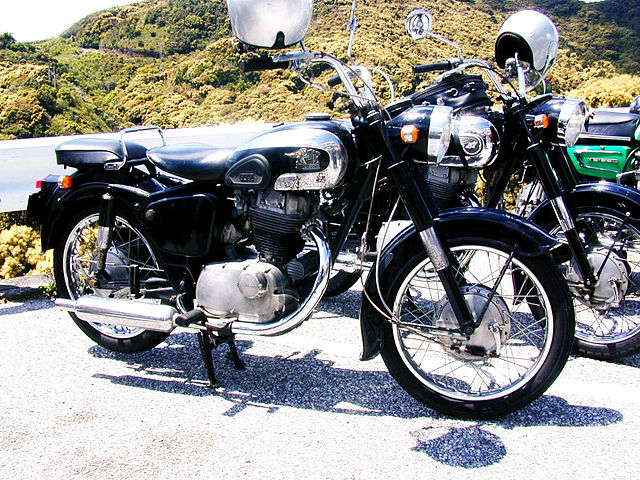Top Qs
Timeline
Chat
Perspective
Meguro motorcycles
Japanese motorcycle brand From Wikipedia, the free encyclopedia
Remove ads
Meguro (Japanese: メグロ) is a brand of motorcycles originally built by Meguro Manufacturing (目黒製作所, Meguro Seisakusho) before the company was absorbed into Kawasaki Heavy Industries. Once a prestige brand, supplying the Japanese government with military and police motorcycles and racing alongside Honda, Meguro became bankrupt after launching a range of lightweight motorcycles which sold poorly, and experiencing a yearlong strike.
The Society of Automotive Engineers of Japan rates the 1937 Meguro Z97 as one of their 240 Landmarks of Japanese Automotive Technology.[1]
Remove ads
History
Summarize
Perspective

Meguro Manufacturing was founded by Nobuji Murata and Takatsugu Suzuki in 1924 to produce motorcycle parts for the nascent Japanese motorcycle industry. Named after a district of Tokyo, Meguro had its roots in Murata Iron Works, which was established in 1922. After the 1929 Wall Street crash, Meguro invested in Harley-Davidson and obtained drawings, tooling and important knowledge of metal heat treatments in order to make gearboxes. These were then used in their vehicles and those of another early Japanese company called Rikuo (陸王; "Land King"). The resulting transfer of American intellectual property taught the Japanese how to produce motorcycles in quantity.

In 1935, Meguro debuted the 500 cc single-powered Z97, based on a Swiss Motosacoche design, but production was restricted due to the start of World War II,[2] during which the company supplied aircraft parts. Meguro started full production again in 1948, the Z97 being joined by models with 125 cc, 250 cc and 350 cc overhead valve singles. In the 1950s, Meguro entered racing and built its first twin-cylinder design, the 651 cc T1 "Senior", with a British-inspired pre-unit parallel twin engine, and later the K series "Stamina" model, a copy of the BSA A7, one of which Meguro had bought in 1953. Its quality and engineering were superior to that of the BSA,[3] and it was described by British motorcycle designer Edward Turner as "too good to be true".[citation needed] For the first time, the Japanese motorcycle industry was seen as a threat.[4] Its other models, designed in collaboration with Kawasaki, were entirely of Japanese design. Meguro raced their 500 cc overhead camshaft single at the Asama Kazan speedway in Tsumagoi, Gunma.[5] For many years, the company was only outsold by Honda.[6] In 1958, Meguro developed a range of 50 cc, 125 cc, 250 cc and 350 cc consumer products, which failed to sell due to being too expensive.[7] By 1960, Meguro was Japan's longest-running motorcycle company out of the hundreds that had once flourished producing copies of European models. The company had become affiliated with Kawasaki; it first changed its name in 1962 to Kawasaki-Meguro, which produced the successful 125 cc B8.[7] Then, in October 1964, seeing the commercial and marketing value of a motorcycle division and Meguro's established sales outlets alongside its heavy industry operations,[8] Kawasaki took full control of the company.[7][9]

"Kawasaki-Meguro Works"-branded 125 cc, 175 cc and 250 cc single-powered motorcycles continued to be sold until 1969. The 500 cc K series twin-cylinder model was later enlarged and developed into the 625 cc Kawasaki W series, which would see use as an official vehicle for government purposes.[10]
Influence on Kawasaki retro models


In 1999, Kawasaki launched the 675 cc parallel-twin W650 with retro styling inspired by the Kawasaki W2,[11] and the 250 cc four stroke single-cylinder Meguro-inspired Estrella. Kawasaki discontinued the W650 in 2007, but replaced it in 2011 with an enlarged version, the 773 cc W800.
Revival
On December 8, 2020, Kawasaki announced the revival of the Meguro brand with a new model—the W800-based K3—available on February 1, 2021. Both the K3 and W800 are mechanically identical, but the K3 is visually distinct and priced higher.[12] The K3 was followed by the S1, a 250 cc single based on the Kawasaki W230, in late 2024.[13]
Remove ads
Former models
Remove ads
References
Wikiwand - on
Seamless Wikipedia browsing. On steroids.
Remove ads

